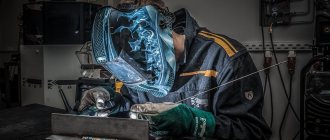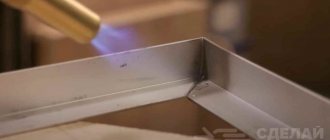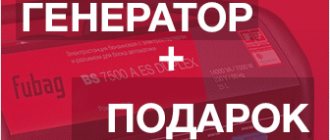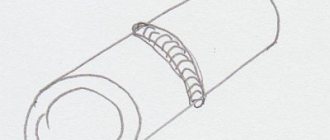The most effective way to create a permanent connection of parts made of aluminum and alloys based on this metal, as practice shows, is welding aluminum with argon. Any welding technology that involves the use of shielding gas requires the use of special equipment, as well as the welder having the appropriate knowledge, qualifications and experience in performing such work. In addition, it is necessary to have at least basic knowledge in the field of metallurgy in order to understand what processes take place in the weld pool.
Aluminum argon arc welding process
What properties of aluminum should be taken into account when welding it?
Understanding the nuances of the processes occurring in the structure of aluminum when performing welding work with it is especially important for novice welders. To understand this well, you need to become familiar with the chemical properties of this metal, which is characterized by its low specific gravity, high strength and exceptional chemical reactivity.
The most significant characteristic of aluminum, which not only experienced but also novice welders should know about, is its ability to quickly react with oxygen, which leads to the formation of a refractory oxide film on the surface of the metal. Typically, aluminum itself can melt at a temperature of 650 degrees, and to melt the oxide film covering its surface, a heating temperature exceeding 2000 degrees is required. When welding with direct current, the unmelted oxide film can be immersed in the molten metal, thereby deteriorating its internal structure.
Argon arc welding diagram
Another feature that should be taken into account when welding this metal is that it does not change its color when heated. Because of this, it is quite difficult to visually determine the degree of heating of the parts being joined, which often leads to burn-throughs and leakage of molten metal during welding.
A property of aluminum that should be taken into account if you are planning to weld parts from this metal is a significant coefficient of its volumetric shrinkage, which often leads to the occurrence of stresses and deformations inside the formed weld and, as a result, to the formation of cracks in it. To avoid such unpleasant consequences, it is necessary to modify the weld or compensate for metal shrinkage by using more welding wire.
Any instruction for welding aluminum, as well as alloys based on it, requires that the specialist performing it is aware of the characteristics of this metal, which include:
- high chemical activity;
- low melting point of the metal itself;
- significant volumetric shrinkage.
Considering all of the above, it can be argued that it is thanks to welding aluminum with argon that high-quality, beautiful and reliable connections of parts are obtained. And if you use semi-automatic equipment to perform such welding, you can effectively solve two problems at once: protect the welding zone from harmful environmental influences, and also compensate for significant metal shrinkage due to the constantly supplied welding wire.
Of course, in addition to this technology, there are other methods of joining aluminum parts using welding, the specifics of which every specialist should know about.
Modes of argon arc welding of aluminum and its alloys
We assemble argon welding from an inverter with our own hands
Argon arc welding is one of the most popular welding technologies. An argon welding machine provides almost limitless possibilities. You can weld any metal with virtually no restrictions on thickness. But a home craftsman always has the opportunity to purchase a factory-made device. And the reasons can be different: from lack of funds to banal distrust of modern manufacturers.
Fortunately, this problem can be solved quite simply and, most importantly, quickly. If you want to save money or for some other reason cannot buy a factory machine, then do-it-yourself argon welding from an inverter is your choice. In this article we will tell you how to assemble an argon apparatus with your own hands.
Aluminum welding methods
In addition to welding, which involves the use of argon as a shielding gas, aluminum parts can be welded using other technologies. The most common are:
- welding performed using a gas torch;
- arc welding;
- argon arc welding.
The first of the above aluminum welding technologies involves the use of filler wire fed into the welding zone, as well as a special flux consisting of fluoride and chloride salts. The flux, which together with the filler rod is heated by the flame of a gas burner, corrodes the oxide film and opens the flame to the base metal, which melts at a fairly low temperature. After completing welding work performed using this technology, it is necessary to immediately wash the surfaces of the parts to be joined in order to wash off any remaining caustic flux from them. The great advantage of this technology is that its use ensures minimal consumption of filler material.
Equipment for semi-automatic welding in argon
To connect aluminum parts, an electric arc welding machine, special aluminum electrodes or filler wire coated with flux can also be used. Welding when using such a device is performed with direct current connected with reverse polarity.
However, as noted above, the highest quality connection can be obtained by argon arc welding of aluminum. When using this technology, heating of the parts to be joined is ensured by an electric arc burning between an infusible tungsten electrode and the workpieces being joined. The formation of a weld occurs through the use of aluminum wire fed into the arc combustion zone manually or mechanically - in semi-automatic welding.
Equipment for manual argon arc welding
The high temperature created when an electric arc burns makes it possible to destroy the oxide film on the surface of the parts being joined, and so that the aluminum does not have time to go into the liquid phase and leak out of the zone of the joint being formed, the welding electrode is moved at a fairly high speed. The big advantage of this welding method is that the electrode, made of refractory tungsten, lasts for a long time, and this allows you to save on consumables.
In order for a weld made semi-automatically using filler wire to have high quality and reliability, it is necessary that the chemical composition of such wire matches the composition of the workpieces being joined to the maximum extent possible.
To perform welding using this technology, today we use devices that generate direct or pulsed current, and there are also devices that use alternating current to weld.
Application of pulsed arc welding
Pulse-arc welding allows you to increase the productivity of welding work; thanks to this technique, a directed jet transfer of metal is created, its spatter is reduced, and the stability of the electric arc also increases.
The use of pulsed arc welding is very promising for welding aluminum structures. Due to the high energy concentration in the pulse, with optimal timing of pulses and pauses, it is possible to ensure stable penetration and correct formation of the weld root, as well as significantly reduce welding deformations.
When welding metal 6 mm thick with a consumable electrode with a diameter of 1.6 mm, the following modes are recommended: pulse repetition rate 100 pulses/s. Current strength I=160-180A, operating voltage U=18-21V, welding speed v=18-25m/h. Welding is done in one pass.
When welding thick metal, it is recommended to use electrodes with a diameter of more than 2 mm. For example, using wire with a diameter of 4 mm, you can weld aluminum alloys (type AMg-61) with a thickness of 90 mm using an X-shaped groove in 5 passes under the following welding modes: I = 450-500 A, U = 22-25 V, v = 21-24 m /h.
Welding large thicknesses due to the high thermal conductivity of the metal requires preliminary and concomitant heating to a temperature of 150°.
Argon welding technology
Welding with argon, which falls under the definition of welding in a shielding gas environment, requires strict adherence to the instructions, which stipulate the sequence of actions performed by a specialist. Both the quality of the formed connection and the consumption of materials, which are not cheap, depend on how correctly all these actions are performed. If you have never performed such welding work, then you need to not only study step-by-step instructions, but also carefully watch video lessons that detail the entire technological process.
To weld aluminum and alloys based on this metal in an argon environment, you need not only the welding machine itself, but also additional equipment that provides storage and supply of consumables. Naturally, the technical condition of such equipment and the quality of all materials used directly affect the reliability of the connection being formed.
To perform argon welding of parts made of aluminum and alloys based on this metal, you will need the following equipment:
- a source of electric current to which the welding machine and all other equipment will be connected;
- a cylinder in which the protective gas argon is stored;
- a mechanism responsible for feeding filler wire into the welding zone.
When welding with argon at large industrial enterprises, shielding gas is supplied to the welding machine through a centralized network. The welding wire used in semi-automatic machines is pre-wound on special reels installed on such a machine. The working surfaces of workbenches on which welding operations are performed, according to the instructions, must be made of stainless steel.
Advantages
- Inert gas is the best protective medium at the moment, which creates conditions impenetrable to oxygen and hydrogen;
- There is no risk of moisture getting into the weld pool from the electrode coating;
- The arc has high combustion stability;
- The seams are more neat and thin, and the welding joints are stronger;
- Many of the disadvantages of aluminum weldability become less significant;
- Ability to work with a wide range of settings modes.
How to prepare parts to be joined for welding
The quality of aluminum argon welding is influenced not only by the technical condition of the semi-automatic machines and other devices used, but also by the thorough preparation of the workpieces being joined.
The step-by-step video below demonstrates all the stages of such preparation well:
To obtain a high-quality connection, it is necessary to thoroughly clean the parts being connected from dirt, grease and traces of machine oil. For such cleaning, it is best to use any solvent. If the thickness of the joined sheet blanks exceeds 4 mm, it is necessary to cut the edges, and the aluminum welding itself must be performed only butt-to-butt. To remove the refractory oxide film from the surface of the workpieces, the joint must be processed using a file or a brush with metal bristles. If the joint has a complex configuration, then such cleaning can be done using a grinding machine.
Preparation of material
To perform proper welding, it is worth preparing the edges of the part or structure that will have to be melted. This event can be carried out both at home and at the factory.
Preparation includes:
- High-quality cleaning of the metal working surface from dirt and degreasing. To carry out the latter, you will need a small amount of acetone or gasoline;
- When welding thin sheets of aluminum, they must be properly processed;
- While preparing, you can worry about cutting apart already welded parts;
- Before starting work, the entire part must be cleaned of oxide film. To do this you will need a stiff brush. You can clean it by resorting to special solvents.
Some features of argon welding
Welding performed in an argon environment has some technological features that a training video cannot always explain. As mentioned above, for such welding, performed semi-automatically or with manual supply of additive, tungsten electrodes are used, the diameter of which is selected in the range of 1.5–5.5 mm. Such an electrode, which forms the welding arc, is located at an angle of 80 degrees to the surface of the parts being connected. If the filler wire is supplied not semi-automatically, but manually, then it is positioned at an angle of 90 degrees relative to the electrode. If you carefully watch the video of aluminum welding with argon, you will notice that the filler wire moves in front of the electrode.
Modes for welding aluminum with a tungsten electrode
When welding with argon, it is very important to ensure that the arc length is within 3 mm. A characteristic feature of such welding is that when it is performed, the filler wire does not make transverse movements.
Argon welding, if it is used to connect sheets of aluminum of small thickness, is performed with a backing, which can be used as a sheet of stainless steel. This allows for improved heat removal from the welding zone, avoiding burns and leakage of molten metal. The use of a backing, among other things, saves energy, since such welding in an argon environment can be performed at a higher speed.
Setting up an argon apparatus
First, the gas flow is adjusted in the range of 6 - 12 l/min using the pressure gauge, which is closer to the hose. When working indoors, the value is set to 1.5 times less than outdoors. Excessive flow creates turbulent turbulence, which mixes gas with air, thereby reducing the reliability of protection of the welding zone.
Depending on the thickness of the workpieces, the current setting of the machine for argon welding is carried out according to the table:
| Metal thickness, mm | Current value, A | Tungsten electrode diameter, mm |
| 1 | 30 — 40 | 1,6 |
| 1,5 | 45 — 60 | 2,3 |
| 2 | 70 -80 | 2,3 |
| 3 | 90 — 120 | 3,2 |
For aluminum the polarity is set to 50/50. However, when working with pure metal, in order to obtain a thin seam and less heating of the electrode, the current balance regulator is shifted towards negative values. For alloys it is better to use the positive range, but without getting carried away. Alternating current with a large positive half-wave is detrimental to the electrode.
The arc decay time when welding a crater, depending on the thickness of the workpiece, is set to 2 - 4 seconds. The duration of argon supply after welding is completed is 3 - 5 seconds.
Epilogue
Aluminum is prepared for welding using each method. Cutting metal edges using the TIG and MIG method is carried out when the material thickness is more than 4 mm. This operation for MMA welding is not performed if the aluminum thickness is less than 20 mm. The use of electric arc, manual arc and semi-automatic welding requires significant costs from the average person. Therefore, a gas burner is often used at home to connect aluminum elements. To obtain the highest quality weld in critical areas, it is necessary to comply with all aluminum welding conditions and use TIG or MIG technology.











